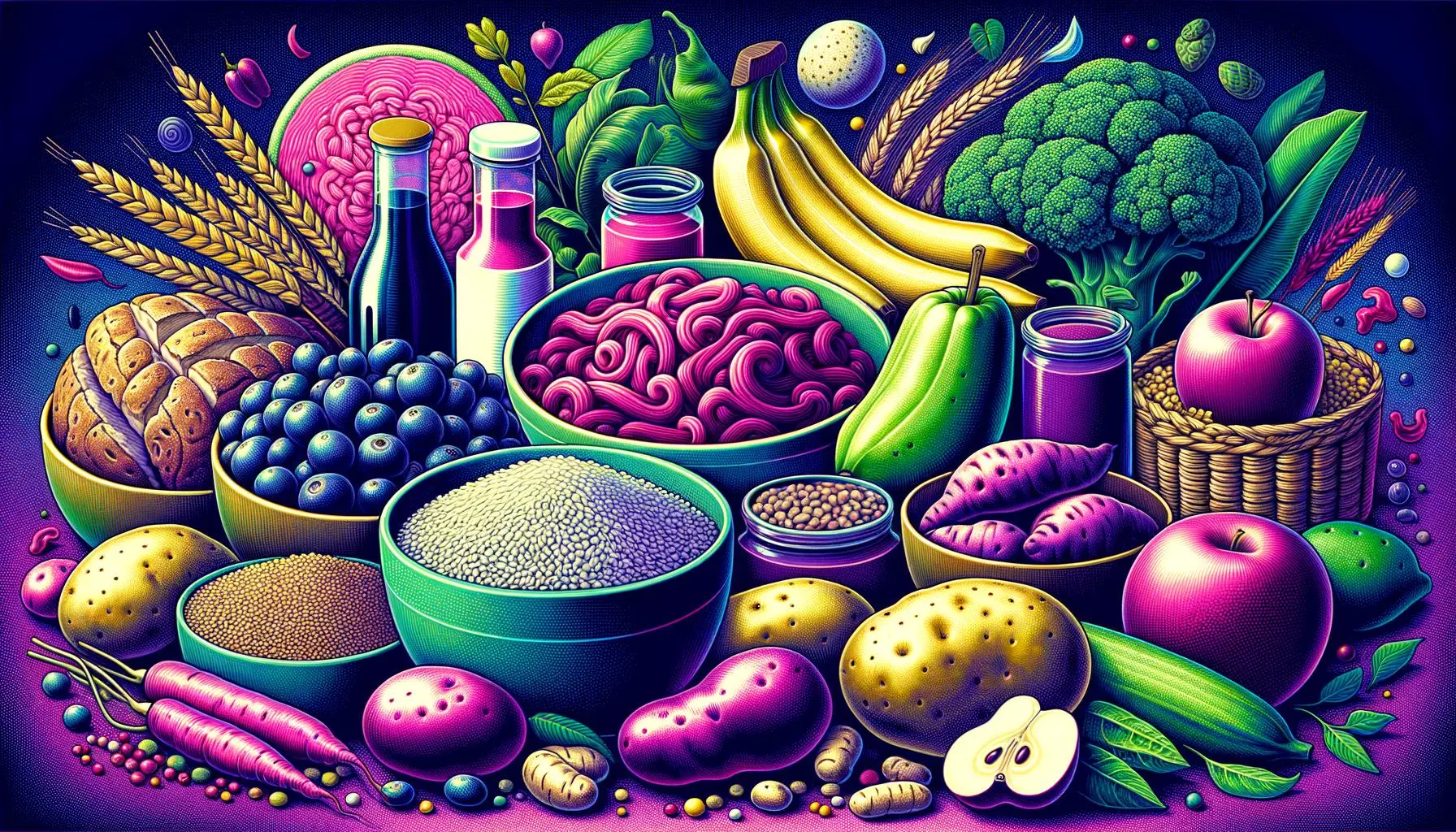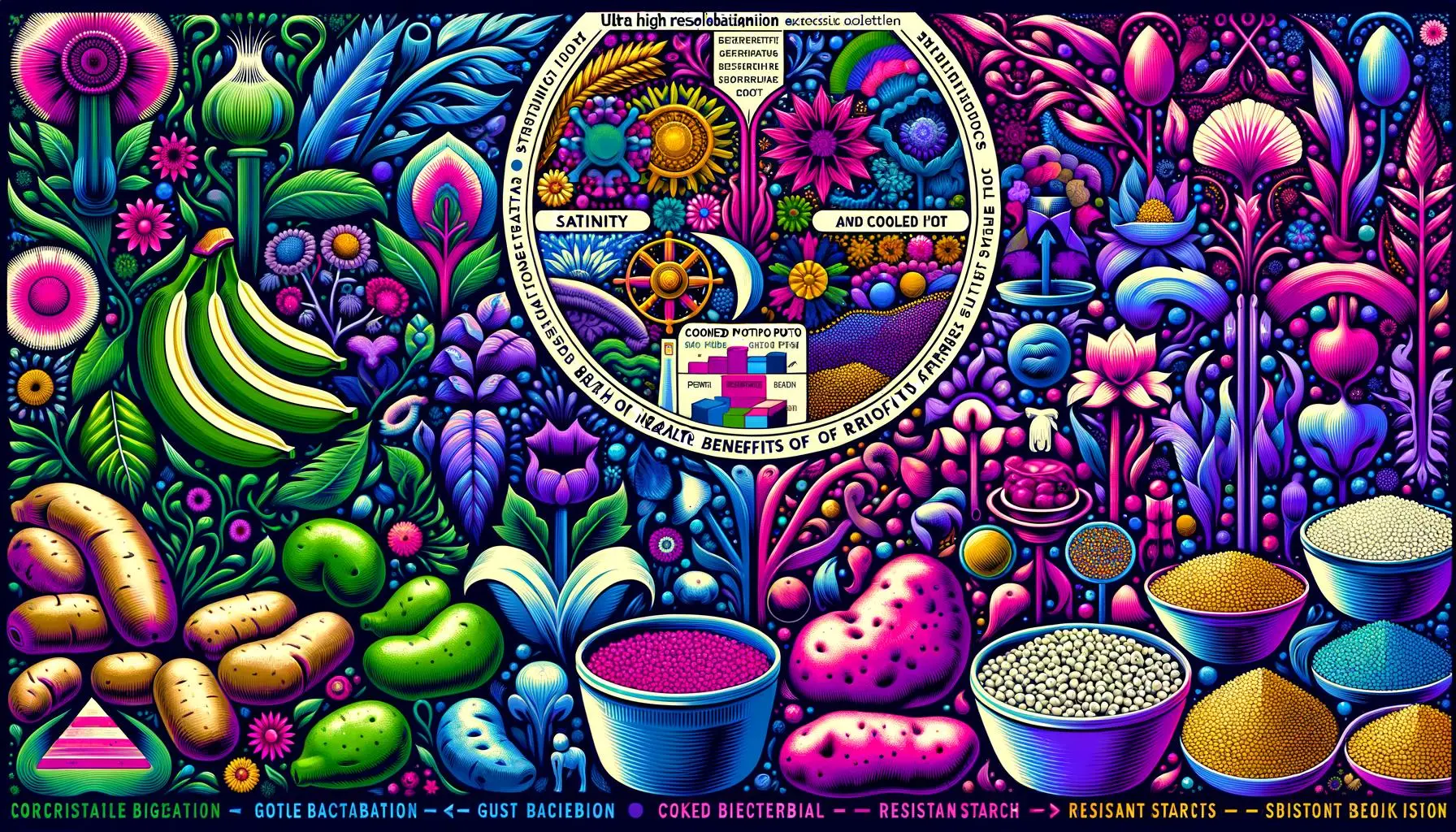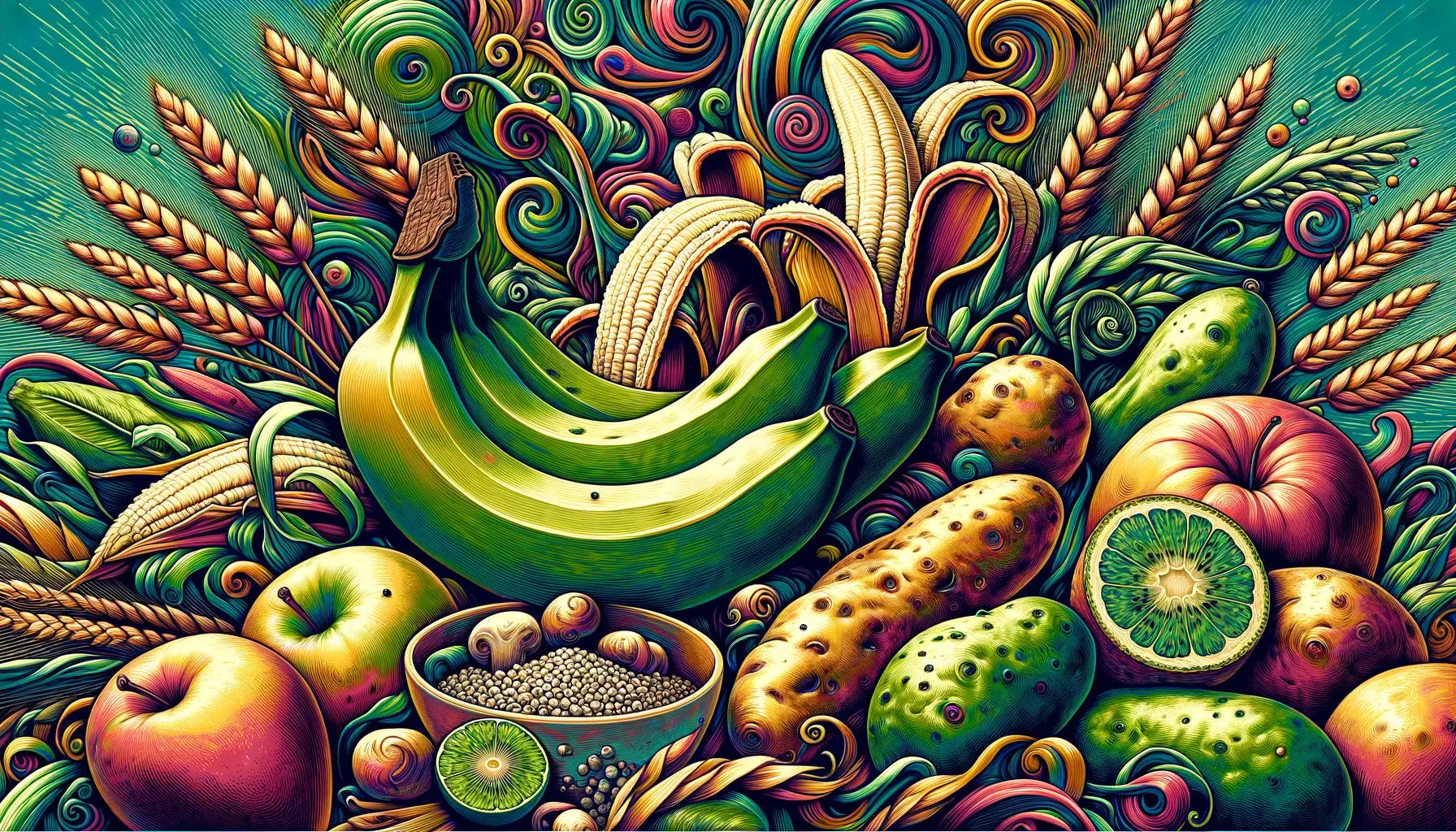· nutrition · 16 min read
Revolutionizing Weight Loss: The Role of Resistant Starch
Discover how incorporating resistant starch into your diet can transform your weight loss journey and promote overall health, backed by science.

In This Post
The Fact Why Should I Care How To Put In Action Start Tomorrow Guide How does it effect my ability to focus How does it impact my daily life How does it help me make friends How does it help me manage stress How does it effect my mood Summary: Remember Refresher Checklist The Full Research Article CitationsPrint Out The Tomorrow Checklist!
Sign up for our newsletter and receive a copy today, so that, you can start tomorrow! Or the next day, or the day after that. I forget everything and starting things is hard at least for me so these checklists are godsend.
Print Out The Remember Refresher Checklist!
Sign up for our newsletter and download your own copy of the Remember Refresher Checklist, so that, you can easily put it on your fridge and help you stay on target towards your WHY. Every little bit helps.
Introduction to Resistant Starch and Weight Loss

The Misconception Around Carbohydrates and Weight Loss
In the journey towards weight loss, carbohydrates often receive a bad reputation. Common diet advice frequently champions reducing carbohydrate intake as a fast track to shedding pounds. However, this simplistic view overlooks the complexity and diversity of carbohydrates as a food group. Not all carbs are created equal, and dismissing an entire macronutrient can lead to missing out on crucial nutritional benefits.
Resistant starch, a unique type of carbohydrate, has emerged as a beneficial component of a healthy diet that can assist in weight management, debunking the myth that all carbs are foes in the fight against fat. Understanding the role of different types of carbohydrates, including resistant starch, can illuminate a path to weight loss that doesn’t compromise on health.
What Is Resistant Starch? Exploring Its Unique Nature
At its core, resistant starch is a form of carbohydrate that isn’t fully broken down and absorbed by the body. Instead of being digested in the small intestine like most carbohydrates, it passes through to the large intestine, where it serves as a food source for beneficial bacteria. This process generates significant health advantages.
The definition of resistant starch encompasses several types, each found in various foods:
- Type 1: Found in grains, seeds, and legumes, protected by an indigestible fiber matrix.
- Type 2: Present in some starchy foods, including raw potatoes and green bananas.
- Type 3: Forms when certain starchy foods, like potatoes and rice, are cooked and then cooled.
- Type 4: A synthetic form created through a chemical process.
Incorporating foods that are high in resistant starch can induce a range of health benefits, including better digestive health, enhanced satiety, and an improved metabolic rate, which directly contributes to weight management.
- [ ] Include a variety of resistant starch-rich foods in your diet daily.
- [ ] Opt for whole, unprocessed sources of carbohydrates.
- [ ] Remember to drink plenty of water to aid in digestion.
- [ ] Start with small portions of resistant starch foods to see how your body reacts.
- [ ] Monitor your body’s response and adjust your diet accordingly.
Understanding the fundamental nature of resistant starch and its benefits can revolutionize how we approach weight loss and overall well-being, moving beyond the misguided demonization of carbohydrates toward a more nuanced, health-forward perspective.
Health Benefits of Resistant Starch

Resistant starch has been increasingly recognized for its unique contributions to health, particularly with regard to gut health, weight management, and metabolic processes.
Feeding the Good Bacteria: The Prebiotic Effect
One of the standout features of resistant starch is its prebiotic nature. Prebiotics are compounds in food that induce the growth or activity of beneficial microorganisms such as bacteria and fungi. Here’s how resistant starch benefits the beneficial bacteria in your gut:
- Nourishes Healthy Gut Microbiota: Resistant starch acts as a food source for the good bacteria in your colon. When these bacteria ferment resistant starch, they produce short-chain fatty acids, which have several beneficial effects on gut health.
- Strengthens the Gut Barrier: The short-chain fatty acids generated from resistant starch fermentation can help strengthen the gut barrier, potentially lowering the risk of certain diseases.
- Improves Digestive Health: By encouraging a healthy balance of bacteria, resistant starch contributes to overall digestive wellness, helping to alleviate issues like constipation.
The fermentation process of resistant starch by gut bacteria not only supports gut health but also translates into wider health benefits.
Enhancing Satiety and Controlling Appetite
A key factor in weight management is controlling appetite and enhancing feelings of fullness, and resistant starch has been found to contribute significantly to this:
- Longer Feeling of Fullness: Resistant starch takes longer to process, helping you feel full longer. This effect aids in reducing the overall intake of food.
- Regulation of Blood Sugar Levels: By slowing the digestion process, resistant starch helps in moderating blood sugar spikes after meals, which in turn can help control hunger and reduce food cravings.
Boosting Metabolism and Fat Burning
Resistant starch can have a positive effect on metabolism and the body’s ability to burn fat:
- Increased Fat Oxidation: Research shows that resistant starch can increase the rate at which fat is oxidized, meaning your body burns more fat for energy instead of storing it.
- Enhanced Energy Expenditure: Incorporating resistant starch in your diet could lead to a slight increase in the amount of energy your body uses for digestion and absorption, contributing to overall weight management.
To incorporate resistant starch into your diet for these benefits, consider adding more green bananas, cooked and cooled potatoes, and whole grains to your meals. Also, be mindful of how your body reacts to these dietary changes and adjust as necessary for optimal health outcomes.
- [ ] Incorporate resistant starch-rich foods in your daily diet.
- [ ] Monitor your digestive health as you increase your intake of resistant starch.
- [ ] Pay attention to satiety signals and adjust your meal portions accordingly.
- [ ] Keep track of your energy levels and weight management progress.
- [ ] Adjust your meal plans as needed to optimize the benefits of resistant starch.
Remember, while resistant starch offers numerous health benefits, it’s important to consume it as part of a balanced diet. Listen to your body and consult with a healthcare professional if you’re contemplating significant dietary changes.
Foods High in Resistant Starch

Resistant starch is becoming a significant topic in the world of health and nutrition, especially among those looking to improve digestive health, manage weight, and optimize their overall well-being. This part of our discussion zones in on a fascinating and often overlooked source of resistant starch: green bananas. Contrary to what most people think, green bananas are not just for smoothies or as a fruit to be eaten when ripe. They hold a myriad of nutritional benefits, particularly their high resistant starch content, which can be incredibly beneficial for gut health, weight management, and metabolic health.
Guide to Green Bananas: Not Just for Smoothies
Green bananas are a staple in many parts of the world, often used in cooking for their unique texture and slightly tangy taste. But beyond their culinary use, green bananas are a powerhouse of resistant starch, especially when they are still unripe. As bananas ripen, the starch content transforms into simple sugars, which means the window for taking full advantage of their resistant starch content is when they are green and unripe.
The Nutritional Benefits of Green Bananas
Green bananas offer a range of health benefits thanks to their high resistant starch content. Here are some of the key nutritional benefits:
- Prebiotic Properties: Resistant starch in green bananas acts as a prebiotic, feeding the good bacteria in the gut and contributing to a healthy gut microbiota.
- Improved Digestive Health: The fermentation of resistant starch produces short-chain fatty acids, which can help maintain a healthy colon and may reduce the risk of colorectal cancer.
- Enhanced Satiety and Appetite Control: Eating foods high in resistant starch, like green bananas, can help you feel fuller for longer, reducing overall calorie intake.
- Weight Management: The satiety signals triggered by resistant starch can aid in weight management efforts by curbing unnecessary snacking or overeating.
- Better Blood Glucose Levels and Improved Insulin Sensitivity: Resistant starch has been shown to have a beneficial effect on blood glucose levels and insulin sensitivity, making green bananas an excellent choice for those monitoring their blood sugar levels.
How to Incorporate Green Bananas into Your Diet
Incorporating green bananas into your diet can be both fun and nutritious. Here’s a simple checklist to get you started:
- [ ] Try adding sliced green bananas to your morning cereal or oatmeal.
- [ ] Experiment with green banana flour as a gluten-free alternative for baking.
- [ ] Make a green banana smoothie by blending it with other resistant starch-rich foods like
cooked and cooled potatoes.
- [ ] Create savory dishes by using green bananas in place of potatoes or other starches.
- [ ] For a simple snack, peel a green banana and eat it with a sprinkle of cinnamon or nutmeg
for added flavor.
Wrap-Up
Embracing green bananas as a source of resistant starch is a straightforward and delicious way to boost your intake of this beneficial nutrient. Whether incorporated into sweet or savory dishes, green bananas can play a critical role in improving your gut health, aiding in weight management, and supporting your overall metabolic health. As we continue to uncover the advantages of resistant starch, green bananas stand out as a versatile and accessible option for anyone looking to enhance their diet with fermentable carbohydrates that support a healthy lifestyle.
Incorporating Resistant Starch into Your Diet

The Art of Cooking with Resistant Starch
Incorporating resistant starch into your diet is more of an art than a science. It’s about creatively integrating foods high in resistant starch into your meals without making radical changes to your eating habits. The key to doing this successfully is to start with familiar dishes and substitute or add ingredients rich in resistant starch. For example, if you’re making a smoothie, consider adding a green banana. Or, if mashed potatoes are on the menu, use cooked and then cooled potatoes. This not only preserves the resistant starch content but also adds a creamy texture to your dishes.
Recipe Ideas: From Breakfast to Dinner
Ideas for integrating resistant starch into your meals are boundless. Here’s how you can start:
Breakfast: Begin your day with a bowl of oatmeal made from cooled, cooked oats mixed with slices of green banana. This meal is not only delicious but also packs a powerful nutritional punch.
Lunch: For a refreshing lunch, prepare a cold potato salad with herbs and olive oil. Remember to cook the potatoes beforehand and cool them to ensure they are high in resistant starch.
Dinner: Integrate whole grains like barley or cooled cooked rice into your dinner recipes. A stir-fry with cooled, cooked rice, vegetables, and your choice of protein can make for a satisfying and healthy dinner.
- [ ] Start with familiar dishes and substitute/add ingredients rich in resistant starch.
- [ ] Integrate green bananas into your smoothies or oatmeal.
- [ ] Use cooked and cooled potatoes for salads or mashed potatoes.
- [ ] Add cooled, cooked whole grains (e.g., barley, rice) into dinner recipes.
Potential Challenges and How to Overcome Them
Integrating resistant starch into your diet may come with challenges, such as adapting to the taste of green bananas or modifying your cooking habits. To overcome these hurdles, start slowly. Incrementally increase the amount of resistant starch-rich foods in your diet, allowing your palate and digestive system to adjust over time. Additionally, experimenting with different recipes can make the transition more enjoyable and less noticeable.
Listening to Your Body: Adjusting Resistant Starch Intake
As you incorporate more resistant starch into your diet, listen to your body. Some people may experience bloating or changes in their digestion. This is typically temporary as your gut microbiome adjusts. However, it’s essential to adjust your intake accordingly. If you experience discomfort, reduce the amount temporarily and then gradually increase it as your body adapts. It’s all about finding the right balance that works for you and your digestion.
Incorporating resistant starch into your diet offers numerous benefits for gut health, weight management, and overall well-being. By following these simple steps and listening to your body’s signals, you can harness the power of resistant starch to enhance your health without disrupting your daily lifestyle.
FAQs on Resistant Starch and Weight Loss

Resistant starch has stirred quite a bit of interest in the weight loss community due to its unique digestive characteristics and potential health benefits. As more people consider incorporating it into their diets, a few common questions arise about its effects on weight loss and digestive health.
How Quickly Can Resistant Starch Impact Weight Loss?
Results can vary significantly from person to person when it comes to weight loss with resistant starch. Several factors influence the timeline, including the amount of resistant starch consumed, individual metabolic rates, and the overall diet. Generally, some individuals may start seeing incremental benefits within a few weeks, especially if they maintain a balanced diet along with regular physical activity. Resistant starch works by enhancing satiety and promoting gut health, which indirectly supports weight management efforts.
Can Resistant Starch Cause Digestive Issues?
While resistant starch can offer numerous digestive health benefits by feeding good bacteria in the gut, it can also cause discomfort for some individuals, particularly when first introduced to the diet. Symptoms like bloating, gas, and changes in bowel habits may occur but are usually temporary. It’s essential to increase intake gradually to give your digestive system time to adjust.
Are There Any People Who Should Avoid Resistant Starch?
Although resistant starch can be a healthy addition to many diets, certain individuals should exercise caution:
- People with IBS or Sensitive Guts: Those with irritable bowel syndrome (IBS) or sensitive digestive systems may find that resistant starch exacerbates symptoms.
- Those on Low-Carb or Ketogenic Diets: Due to its carbohydrate content, those strictly managing carbohydrate intake should consider the potential impact on ketosis.
- Individuals with Uncontrolled Diabetes: While resistant starch can help with blood sugar management, those with uncontrolled diabetes should consult a healthcare professional to monitor effects on blood glucose levels.
- Start with a small amount of resistant starch and increase gradually
- Monitor your body's response to resistant starch additions
- Consult a healthcare professional if you have IBS, are on a low-carb or ketogenic diet, or
have uncontrolled diabetes
- Be aware of increased gas or bloating as potential temporary side effects
- Combine resistant starch intake with a balanced diet and regular exercise for optimal weight
loss results
Resistant starch presents an exciting frontier for those pursuing health and weight-loss goals. While it is not a magic bullet, its incorporation into a balanced diet might offer substantial benefits. Always listen to your body and consult healthcare professionals to tailor dietary changes to your needs.
Reflecting on the Power of Resistant Starch

Throughout this detailed exploration of resistant starch, we’ve dived deep into its compelling potential for revolutionizing weight management and enhancing overall health. The journey from unraveling the myths around carbohydrates to discovering the myriad of health benefits resistant starch presents, including its prebiotic properties, capacity to boost metabolism, and its role in fat burning, leads us to a pivotal conclusion about its role in our diets.
The Recap: Unlocking the Benefits of Resistant Starch
Reflecting on what we’ve learned, it’s clear that incorporating foods rich in resistant starch into our diet—such as green bananas, cooked and cooled potatoes, and whole grains—offers a powerful tool for weight management and digestive health. By fostering a healthy gut microbiota, improving satiety signals, and promoting better blood glucose levels, resistant starch can indeed play a pivotal role in modern dieting strategies.
Moreover, its indirect contributions to increasing our metabolic rate and enhancing nutrient absorption underscore its importance, not just for those looking to manage their weight, but for anyone interested in maintaining optimal health.
The Future of Dieting: Embracing Complexity for Holistic Health
The narrative around dieting and weight loss is undergoing a fundamental shift, moving away from oversimplified notions of calorie counting towards a more nuanced understanding of how diverse nutrients impact our body in multifaceted ways.
Resistant starch stands out as a shining example of this complexity, encouraging us to consider not just the quantity of the foods we eat, but the quality and nature of their nutritional content. Its ability to act as a fermentable carbohydrate, feeding our gut bacteria and influencing systemic health, positions resistant starch as a cornerstone of a future where dieting is not about restriction, but about nurturing our bodies.
- [ ] Incorporate more green bananas into your diet
- [ ] Experiment with recipes using cooked and cooled potatoes
- [ ] Include a variety of whole grains in your meals
- [ ] Monitor your body's response to increased resistant starch intake
- [ ] Consult with a nutritionist for personalized dietary advice
Embracing Resistant Starch in Your Journey to Health
Incorporating resistant starch into your diet is a journey, one that involves listening to your body and adapting based on its responses. The checklist above provides a simple guide to start this journey, encouraging you to experiment with and gradually introducing resistant starch into your diet for its numerous health benefits.
As we look towards the future, it’s clear that our understanding of nutrition continues to evolve. Embracing the complexities of food and its effects on our body is crucial for holistic health and well-being. Resistant starch represents just one component of this ongoing journey, but its potential is undeniable, making it a valuable ally in the quest for better health and effective weight management.
In closing, let us embrace the power of resistant starch, recognizing its role in fostering not just a healthier gut, but a healthier life. The path to weight loss and optimal health is multifaceted, and resistant starch is a key piece of this complex puzzle. By integrating it into our diets, we take a step forward in revolutionizing the way we think about food, nutrition, and our bodies.
Relevant Links on Resistant Starch

The journey through understanding and incorporating resistant starch into your diet is an exciting one that opens doors to improved gut health, weight management, and overall well-being. As we wrap up our comprehensive exploration of resistant starch, it’s beneficial to connect with further resources that can expand your knowledge and application of this powerful dietary component.
Exploring More on Resistant Starch and Its Benefits
Below, find three invaluable resources that dive deeper into the intricacies of resistant starch, its role in fostering a healthy microbiome, its impact on dietary fibers and weight management, and a broader look at understanding carbohydrates and fiber for health:
- Exploring the Microbiome’s Role in Health - American Gut Project
- Research on Dietary Fibers and Weight Management - National Center for Biotechnology Information
- Understanding Carbohydrates and Fiber - Harvard T.H. Chan School of Public Health
Each website provides valuable insights and research findings on how resistant starch and fermentable carbohydrates play critical roles in our health, touching on aspects such as prebiotic properties, metabolic rate enhancement, and the stabilization of blood glucose levels.
Quick Checklist before You Go
To ensure you’re well-prepared to continue your journey with resistant starch, here’s a quick checklist:
- [ ] Explore the recommended links for deeper insights into resistant starch.
- [ ] Integrate foods high in resistant starch, like green bananas, cooked and cooled
potatoes, and whole grains, into your diet.
- [ ] Monitor your body's response to increased resistant starch intake, adjusting as needed
for comfort and health.
- [ ] Consult healthcare professionals if you have underlying health conditions or concerns
regarding dietary changes.
- [ ] Share your own experiences and learnings about resistant starch with others to foster
greater understanding and application.
By delving into these resources and keeping the checklist in mind, you’re on your way to mastering the integration of resistant starch into your daily diet for optimal health benefits. Remember, the journey to improved well-being is a personal one, so listen to your body, stay informed, and enjoy the transformative power of resistant starch in your life.





